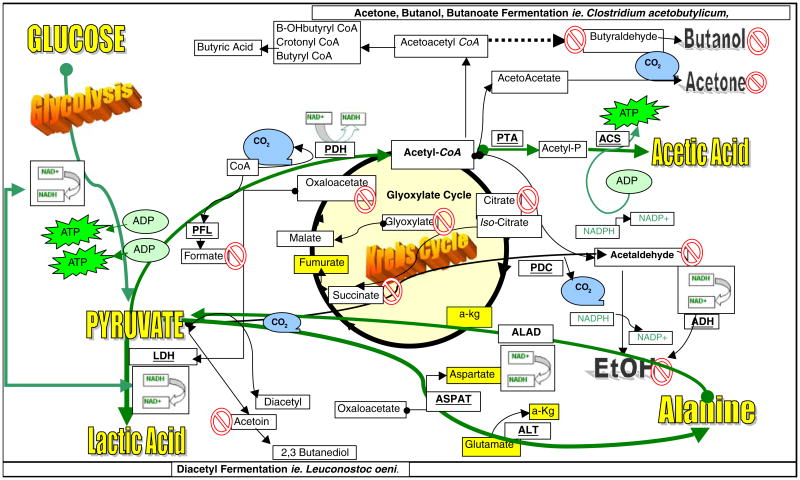Fig. 5.
Carbohydrate metabolism and fermentation in tumor cells. Glucose metabolism in malignant neuroblastoma occurs primarily through glycolysis where pyruvate is converted to lactate via LDH with NADH reduced to NAD+. NAD+ drives substrate-level phosphorylation through phosphoglycerate kinase and pyruvate kinase producing energy in the form of ATP through glycolysis (Armstrong 1983). While tumor cells have a mitochondria, its function is expendable, resulting in meager amount of pyruvate converted to acetyl-CoA through mitochondrial pyruvate dehydrogenase (PDH). An absence of [formic acid] in this study indicates that conversion of pyruvate to acetyl-CoA + formate through pyruvate formate-lyase (PFL) is not likely. An absence of accumulated [isocitrate], [succinate], or [glyoxylate] suggests a lack of a functional glyoxylate cycle. Absence of [acetaldehyde] accumulation indicates that pyruvate conversion to acetaldehyde through pyruvate decarboxylase (PDC) or acetaldehyde to [alcohol] through alcohol dehydrogenase (ADH) is unlikely events required for anaerobic fermentation. A lack of [acetoin] indicates that conversion of pyruvate through the diacetyl/acetoin biosynthetic pathway is unlikely, and a lack of quantifiable [aldehydes and/or ketones] in general suggests that butanoate fermentation is not likely involved with energy metabolism as well. The quantifiable accumulation of [L-alanine] in conjunction with several amino acids (yellow highlighted) such as [aspartate], [glutamate], and [α-ketoglutarate] suggests potential involvement of pyruvate–alanine transaminase (ALT) or L-alanine/oxaloacetate aminotransferase (ASPAT) pathway. L-alanine could be reconverted to pyruvate through L-alanine dehydrogenase (ALAD) to regenerate NADH to drive LDH. Evidence also suggests that pyruvate may be condensing with coenzyme A to form acetyl-CoA which is converted to acetyl phosphate by phosphotransacetylase (PTA) and [acetate] by acetyl-CoA synthetase (ACS) which is a reaction that could contribute to a second source of ATP production

